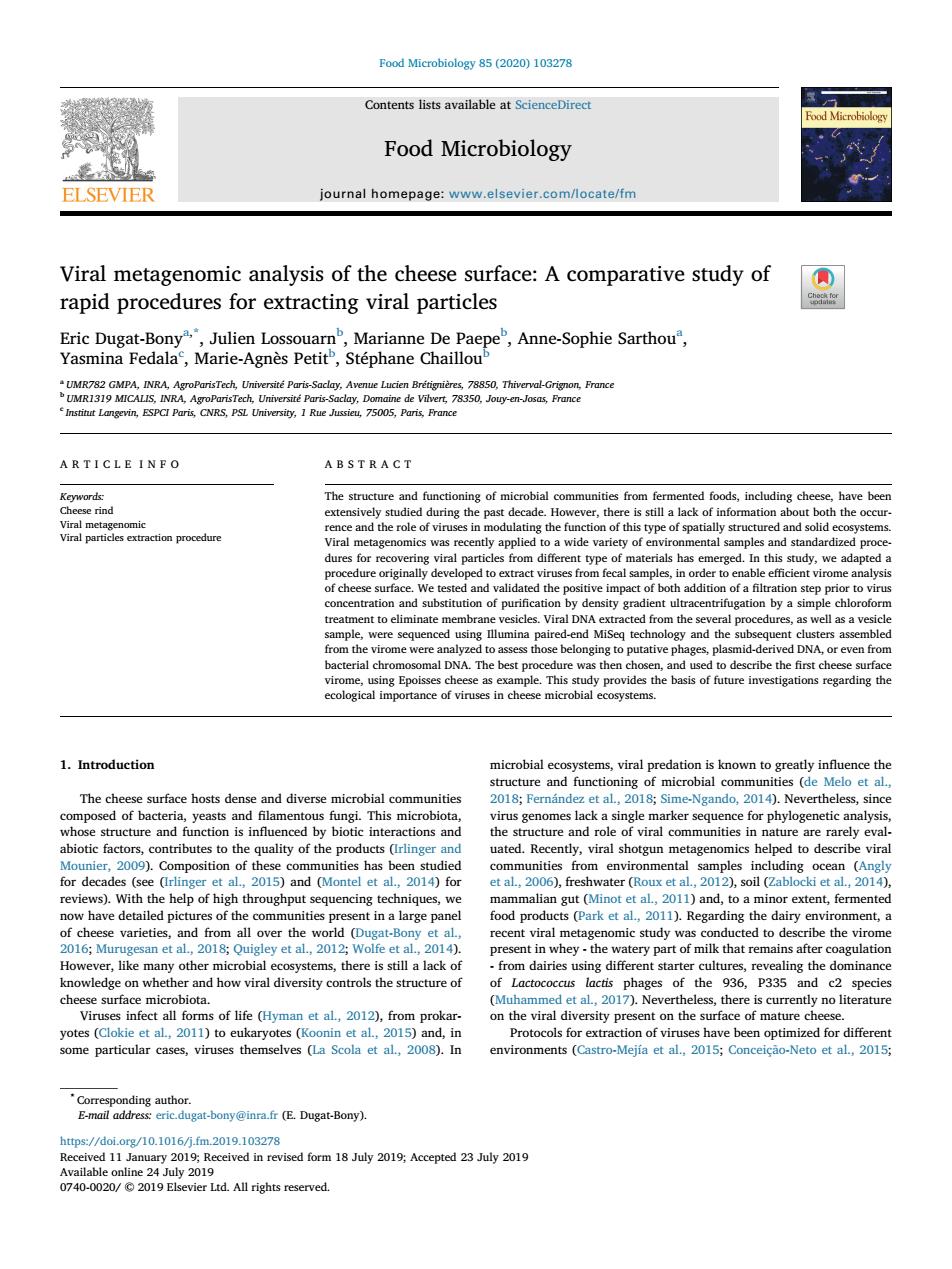正在加载图片...

Food Mierobiology 85 (2020)103278 Contents lists available at ScienceDirect Food Microbiology ELSEVIER journal homepage:www.elsevier.com/locate/fm Viral metagenomic analysis of the cheese surface:A comparative study of rapid procedures for extracting viral particles ARTICLEINFO ABSTRACT The structure and functioning of microbial comm have nng the past decad ures for r ng ral part ced usin nd the acterial chr DNA.T best proce 1.Introduction microbial eco ms,viral predation is known to greatly infuence the The cheese surface hosts dense and diverse microbial comm unitie 1c02010.Ne ated.Kecenty. viral shotgun metagenomics helped to describe vira tal.20061. atcrR food products (Park).Regar ing the dairy environment.a ng din a,2017.N ss,there is noliterature t al 2011)to eukaryotes n et al.,2015) e particul in revised,AcceptedContents lists available at ScienceDirect Food Microbiology journal homepage: www.elsevier.com/locate/fm Viral metagenomic analysis of the cheese surface: A comparative study of rapid procedures for extracting viral particles Eric Dugat-Bonya,* , Julien Lossouarnb , Marianne De Paepeb , Anne-Sophie Sarthoua , Yasmina Fedalac , Marie-Agnès Petitb , Stéphane Chailloub a UMR782 GMPA, INRA, AgroParisTech, Université Paris-Saclay, Avenue Lucien Brétignières, 78850, Thiverval-Grignon, France b UMR1319 MICALIS, INRA, AgroParisTech, Université Paris-Saclay, Domaine de Vilvert, 78350, Jouy-en-Josas, France c Institut Langevin, ESPCI Paris, CNRS, PSL University, 1 Rue Jussieu, 75005, Paris, France ARTICLE INFO Keywords: Cheese rind Viral metagenomic Viral particles extraction procedure ABSTRACT The structure and functioning of microbial communities from fermented foods, including cheese, have been extensively studied during the past decade. However, there is still a lack of information about both the occurrence and the role of viruses in modulating the function of this type of spatially structured and solid ecosystems. Viral metagenomics was recently applied to a wide variety of environmental samples and standardized procedures for recovering viral particles from different type of materials has emerged. In this study, we adapted a procedure originally developed to extract viruses from fecal samples, in order to enable efficient virome analysis of cheese surface. We tested and validated the positive impact of both addition of a filtration step prior to virus concentration and substitution of purification by density gradient ultracentrifugation by a simple chloroform treatment to eliminate membrane vesicles. Viral DNA extracted from the several procedures, as well as a vesicle sample, were sequenced using Illumina paired-end MiSeq technology and the subsequent clusters assembled from the virome were analyzed to assess those belonging to putative phages, plasmid-derived DNA, or even from bacterial chromosomal DNA. The best procedure was then chosen, and used to describe the first cheese surface virome, using Epoisses cheese as example. This study provides the basis of future investigations regarding the ecological importance of viruses in cheese microbial ecosystems. 1. Introduction The cheese surface hosts dense and diverse microbial communities composed of bacteria, yeasts and filamentous fungi. This microbiota, whose structure and function is influenced by biotic interactions and abiotic factors, contributes to the quality of the products (Irlinger and Mounier, 2009). Composition of these communities has been studied for decades (see (Irlinger et al., 2015) and (Montel et al., 2014) for reviews). With the help of high throughput sequencing techniques, we now have detailed pictures of the communities present in a large panel of cheese varieties, and from all over the world (Dugat-Bony et al., 2016; Murugesan et al., 2018; Quigley et al., 2012; Wolfe et al., 2014). However, like many other microbial ecosystems, there is still a lack of knowledge on whether and how viral diversity controls the structure of cheese surface microbiota. Viruses infect all forms of life (Hyman et al., 2012), from prokaryotes (Clokie et al., 2011) to eukaryotes (Koonin et al., 2015) and, in some particular cases, viruses themselves (La Scola et al., 2008). In microbial ecosystems, viral predation is known to greatly influence the structure and functioning of microbial communities (de Melo et al., 2018; Fernández et al., 2018; Sime-Ngando, 2014). Nevertheless, since virus genomes lack a single marker sequence for phylogenetic analysis, the structure and role of viral communities in nature are rarely evaluated. Recently, viral shotgun metagenomics helped to describe viral communities from environmental samples including ocean (Angly et al., 2006), freshwater (Roux et al., 2012), soil (Zablocki et al., 2014), mammalian gut (Minot et al., 2011) and, to a minor extent, fermented food products (Park et al., 2011). Regarding the dairy environment, a recent viral metagenomic study was conducted to describe the virome present in whey - the watery part of milk that remains after coagulation - from dairies using different starter cultures, revealing the dominance of Lactococcus lactis phages of the 936, P335 and c2 species (Muhammed et al., 2017). Nevertheless, there is currently no literature on the viral diversity present on the surface of mature cheese. Protocols for extraction of viruses have been optimized for different environments (Castro-Mejía et al., 2015; Conceição-Neto et al., 2015; https://doi.org/10.1016/j.fm.2019.103278 Received 11 January 2019; Received in revised form 18 July 2019; Accepted 23 July 2019 * Corresponding author. E-mail address: eric.dugat-bony@inra.fr (E. Dugat-Bony). Food Microbiology 85 (2020) 103278 Available online 24 July 2019 0740-0020/ © 2019 Elsevier Ltd. All rights reserved. T